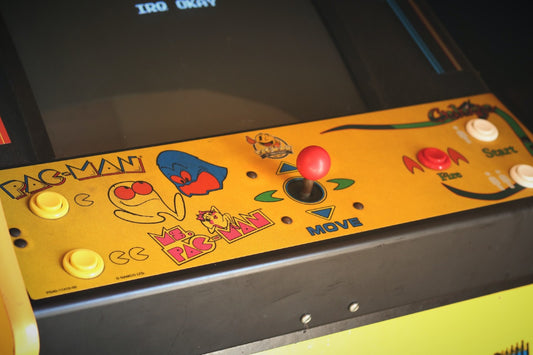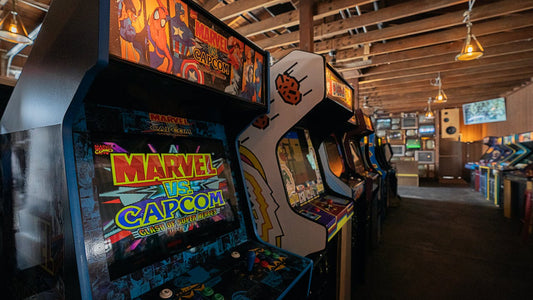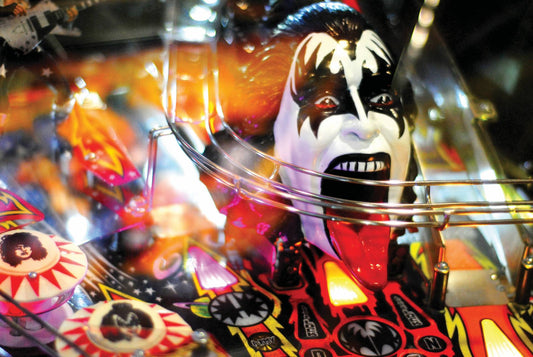The Simpsons + TMNT
The Simpsons
Based on the television hit comedy show, the Simpsons invaded the world of the arcade machines in 1991. The game was in the beat em up genre where the Simpsons’ family had to fight various enemies to rescue the kidnapped Maggie.
The game follows Homer, Marge, Bart, Lisa and Maggie on a family trip through town when they witness a robbery at the jewellers. Smithers is looting the store and in a hurry bumps into Homer which leads to the diamond he is carrying falling into Maggie’s mouth like a dummy; he then picks her up and escapes the scene.
Being a four-player cabinet allowed the player to either choose their preferred character or play with three other friends to complete the family and find Maggie! The players would be required to battle their way through familiar areas including Krustyland, Moe’s Tavern and Dreamworld; finally arriving at the Springfield power-plant to take on Smithers and Burns face to face.

Each character had their own specialised attack, these being Marge swinging her vacuum, Homer punching and kicking, Bart using his skateboard as a weapon and Lisa attacking with a jump-rope. However, when acting together, two players can perform a joint attack such as Homer ad Marge creating a powerful cartwheel attack.
To increase their health, the player could pick up pieces of food randomly spotted around the various areas. With only few lives per character, when the lives eventually run out a devil-Bart will appear and the player will only have a few seconds to enter more coins if they wished to do so. Every few rounds the players would be put head to head in mini-games that would allow them to gain additional points.
The Japanese release of the game differed massively from the worldwide version of the game. Including a life bar that could expand to three levels when eating food on full health and your health being reset at the start of every level as the remaining lives would be converted into points. Other features include weapons such as a small scale nuclear bomb that would obliterate every on-screen enemy.
Standing as a legendary arcade game, the Simpsons was ported onto the Commodore 64. In 2012 the game was revived with special features and being up-scaled to HD for release on PlayStation Plus and Xbox Live Arcade. Though the game was taken off only a year later with no explanation as to why from both companies and Konami.
It is obvious to see the success of the game, which has even been dubbed the ‘best cartoon-based arcade game of all time’.
Teenage Mutant Ninja Turtles
Based on the popular 1987 animated show, Teenage Mutant Ninja Turtles (or Teenage Mutant Hero Turtles in the UK) moved into the arcade world in 1991. The game was four player, though came in both two and four player cabinets.
Choosing from the four Ninja Turtles (Leonardo, Michelangelo, Donatello and Raphael) the player must fight against the evil Shredder who has kidnapped the turtles’ friend April O’Neil and mentor Splinter.

The player can control their chosen turtle through jump and attack buttons as well as a joystick. Combos were possible in the game and are listed below with the characters’ normal attacks.
Each of the turtles have their own style of attack: Donatello has generally slower attacks but a wider range, whilst having a special attack of rolling along the floor and finishing with a kick; Raphael and Michelangelo can attack at speed but in a shorter range. Leonardo is a well-rounded player with an average speed and range when attacking. Leonardo, Raphael and Michelangelo all share a special attack of a sweeping jump. The turtles can also jump off walls in certain areas, as well as use objects such as traffic cones and fire hydrants as weapons.
The majority of enemies faced in the game are foot soldiers, though bosses do include the popular enemies from the series Bebop and Rocksteady, Baxter Stockman, Granitor, General Traag, Krang and finally Shredder.



